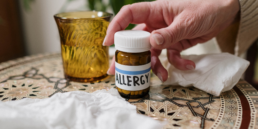An allergy is an exaggerated immune reaction to a normally harmless substance known as an allergen. When a susceptible person is first exposed to an allergen, the immune system does not necessarily react, but stores this foreign substance in its memory. Later re-exposure may result in antibodies releasing substances, such as histamine, triggering a range of reactions.
Allergies vary in intensity and can take many forms including atopic dermatitis (eczema), asthma, and allergic rhinitis.
There are two types of allergic rhinitis:
• Seasonal (acute): occurs at specific times of the year only (e.g., ragweed, tree and grass pollen);
• Perennial (chronic): occurs year-round, usually a reaction to indoor allergens (e.g., dust mites, pet dander, mould).
CAUSES AND TRIGGERS
The tendency to develop allergies appears to be hereditary. If one or both parents suffer from allergies, their children are more likely to develop allergies.
PREVENTION AND TREATMENT
The best prevention is to avoid contact with allergens. Since this is not always possible, try to limit exposure. To reduce allergy symptoms:
Allergy sufferers may experience one or several of the following symptoms:
- Runny nose with clear discharge
- Sneezing
- Itchy nose
- Nasal or sinus congestion
- Headache
- Postnasal drip
- Scratchy throat
- Red, inflamed skin and mucous membranes (e.g., the lining in the mouth)
- Red eyes
- Itchy eyes
- Watery eyes
- Difficulty breathing, wheezing
- Cough
- Asthma (in severe cases)
- Hives (itchy skin rash)
- Anaphylactic shock
Caused by dust and dust mites:
- Keep humidity levels in the house between 40-45%, limit the use of humidifiers;
- Avoid having rugs and carpets, knickknacks and other items that collect dust;
- Avoid having pets in the house;
- Wash bedding in hot water, at least every 2 weeks;
- Use specially designed allergy-proof mattress and pillow covers;
- Rather than vacuuming and sweeping, clean floors and other surfaces with a damp cloth;
- Do not smoke.
During pollen season (when pollen is carried by the wind):
- Monitor pollen forecasts for your area to better
plan outings; - Set the air conditioner at home and in the car to
“recirculate” so windows can be kept closed; - Plan outdoor activities in the afternoon when
pollen counts are lowest (highest in the
morning); - Avoid outdoor activities on very windy or sunny days when pollen counts are at their highest. Rain makes pollen fall to the ground;
- Shower and wash hair after outdoor activities;
- Do not line-dry clothes and bedding.
There is a vast array of treatments available, and many of them are available without a prescription. Generally speaking, starting treatment before exposure to the allergen is more effective than starting when symptoms are already present. Speak to your pharmacist to see which product is best for you.
The use of a saline solution to irrigate the nasal passages may help improve symptoms of allergic rhinitis.
Another option is allergy desensitization. This involves the administration of small amounts of allergy-triggering substances to build tolerance, reducing the intensity of symptoms upon re-exposure.
WHEN SHOULD I SEE A HEALTHCARE PROFESSIONAL?
Consult your healthcare professional if:
- Your symptoms persist or prevent you from doing your daily activities as you usually would;
- Over-the-counter drugs do not relieve your symptoms;
- Drugs cause side effects that your body does not tolerate.
To participate in your diagnosis, provide your doctor with basic information such as symptoms, time of day or season, and substances believed to be responsible. Painless skin tests may also be ordered.
FOR MORE INFORMATION:
Canadian Society of Allergy and Clinical Immunology
Free delivery on prescriptions and medical supplies.
We offer free local delivery, curbside pick-up, and Canada wide shipping.

